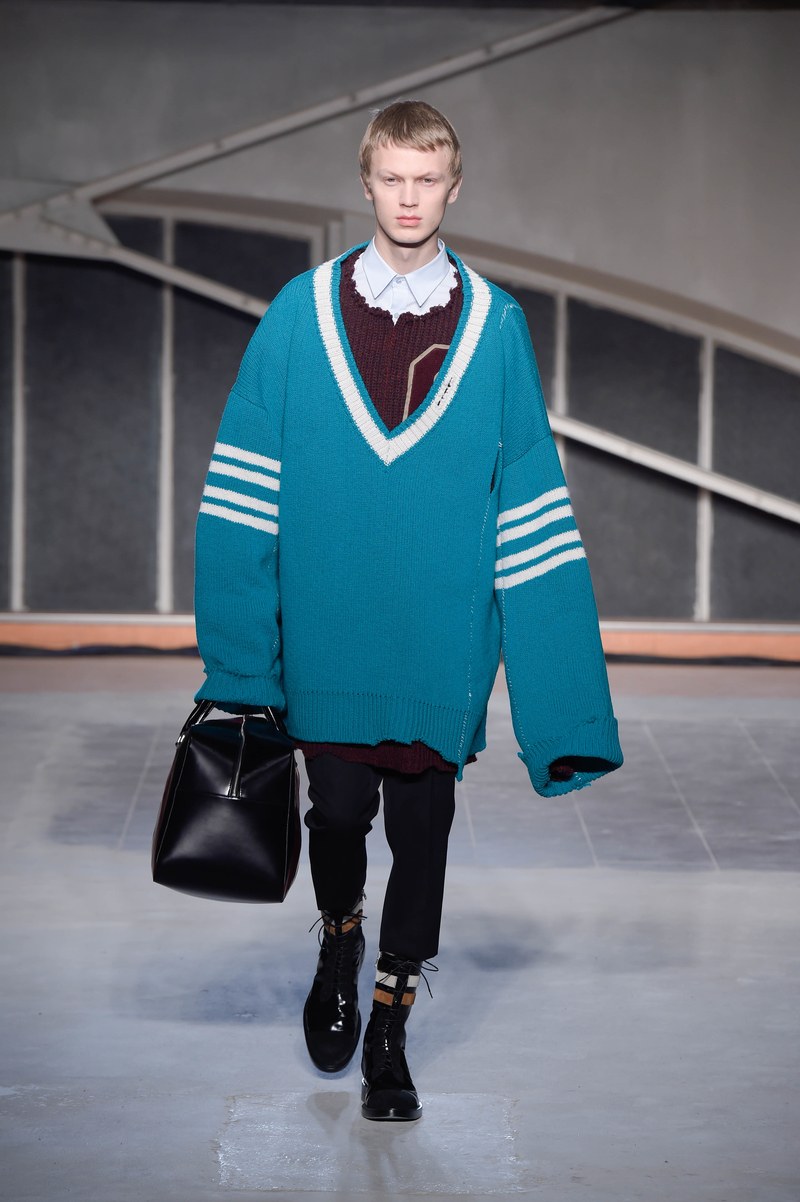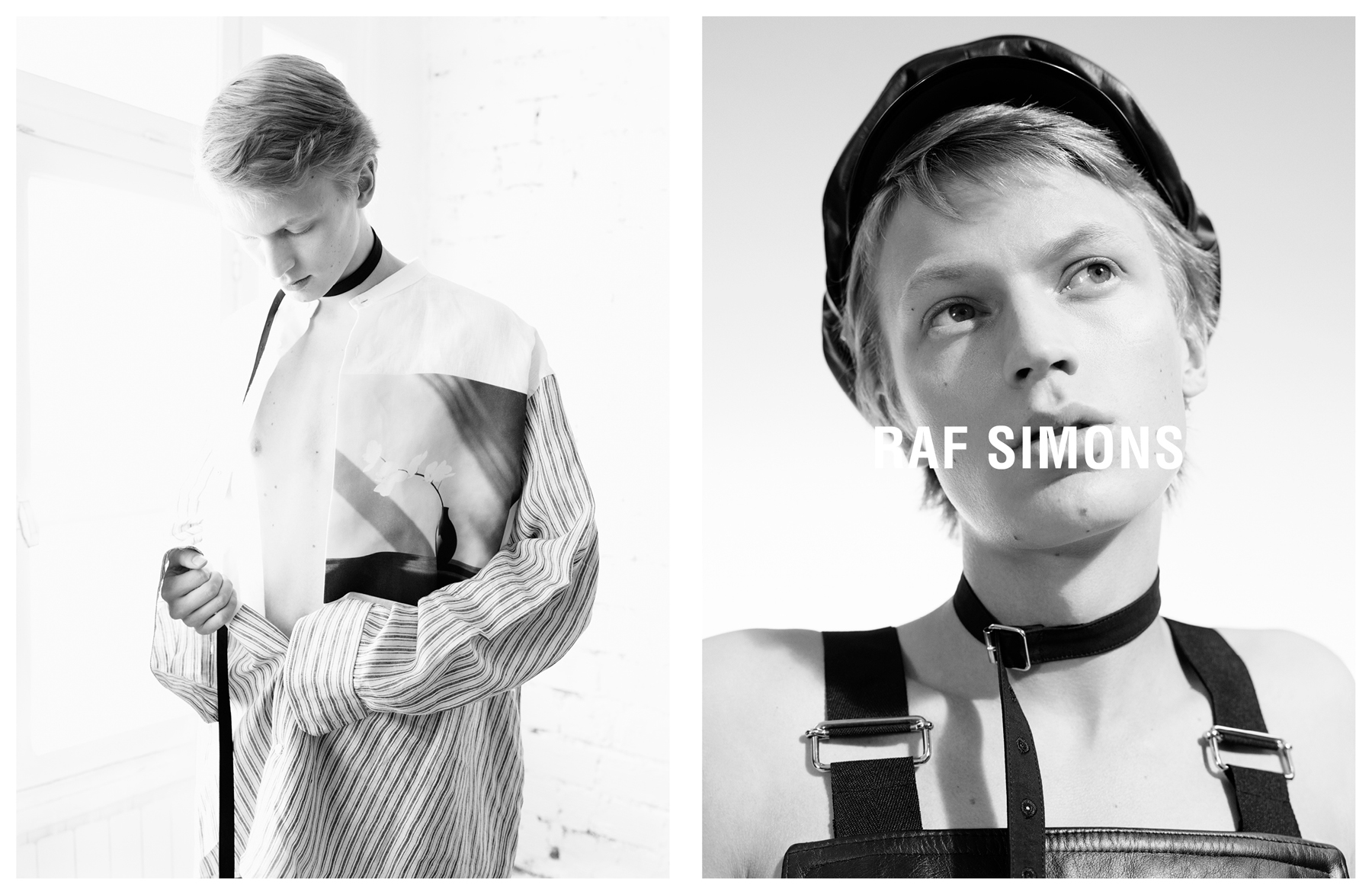
Raf Simons
designer
Raf Simons (° 1968, Neerpelt) is a well known Belgian fashion designer who graduated in Industrial Design and Furniture Design at Higher Institute for Visual Communication in Genk in 1991. He began working as a furniture designer for various galleries, having previously interned at the design studio of Walter Van Beirendonck between 1991-1993.
Van Beirendonck took him to Paris Fashion Week and that was when Simons first saw a fashion show — Martin Margiela’s all-white show in 1991 — which inspired Simons to turn to fashion design.
Encouraged by Linda Loppa, head of the fashion department at the Antwerp Royal Academy at the time and now director of the prestigious italian fashion school Polimoda , Simons became a self-trained menswear designer and launched his Raf Simons label in 1995.
His first collection was in Fall-Winter 1995, and featured two street models in a video presentation. From Fall-Winter 1995 to Spring-Summer 1997, Simons’ collections were shown either in presentations or videos. Fall-Winter 1997 saw his first runway show in Paris, France with a look of ‘American college students and English schoolboys with a background of New Wave and Punk’.
Simons’ early aesthetic incorporated youth culture from divergent sources, such as the Spring-Summer 2000 collection taking inspiration from both MENSA students and the Gabba youth subculture (a predominantly Dutch and Belgian movement associated with hardcore techno music). Music has formed an integral part of Simons’ work, with references to musical figures such as the Manic Street Preachers’s Richey Edwards and Joy Division’s Ian Curtis and his Fall-Winter 1998 collection (Radioactivity) featuring members of German electro band Kraftwerk as models.
In March 2000, Simons shut down his company to take a sabbatical after his Fall-Winter 2000 collection (Confusion). Following a new deal with Belgian manufacturer, Gysemans Clothing Industry, the company was started back up again for Fall-Winter 2001. During this time, Simons’ international prominence grew with the collection for Spring-Summer 2002 (Woe Onto Those Who Spit On The Fear Generation…The Wind Will Blow It Back) becoming one of his most influential due to its ‘layered, hooded, sinister image of the urban guerrilla’.
In 2003, Simons received the Swiss Textiles Award, receiving material benefits at the value of €100,000.
The company was restructured in October 2004 with a distribution deal with Futurenet (Europe and USA) and Mitsui (Asia), followed by a license agreement with Futurepresent (joint-venture of Futurenet and Mitsui Italia). This deal came to an end with the Spring-Summer 2011 collection.
The aesthetic of the Raf Simons brand has changed since 2005, as former Arena Homme Plus editor Jo-Ann Furniss asserts: “The key turning point was A/W 04-05 (Waves), when the obsessive youth culture codes of his past were turned into clothes that were purely about shape and form.”
In June 2005, Raf by Raf Simons was launched, which was sold at a lower price point. Simons also released the book Raf Simons: Redux about the first 10 years of his career. Alongside the publication, there was also an exhibition of Simons’ work and an outdoor fashion show at the Pitti Immagine Uomo tradeshow in Florence, Italy for a retrospective of the designer’s career at the age of 38.
In 2008, two flagship Raf Simons stand-alone stores opened in Tokyo and Osaka, Japan, in collaboration with the artists Sterling Ruby and Roger Hiorns.
Autumn-Winter 2009 saw the first Raf Simons advertising campaign, photographed by Willy Vanderperre.
In 2011, Raf by Raf Simons was replaced by Raf Simons 1995, a diffusion line incorporating elements from Simons’ early collections. Raf Simons 1995 also includes homeware, namely blankets and cushions.
Collaborations
Since 2008, Simons has created collections in collaboration with British brand Fred Perry. From Spring-Summer 2008 onwards, Simons has collaborated with Linda Farrow on a collection of sunglasses for the brand. Since Fall-Winter 2009, Simons has also collaborated with running shoe manufacturer Asics. For the Fall-Winter 2013 show, a new limited-edition footwear collaboration with Adidas was announced featuring five different designs.
Simons has designed three collaborations with American bag manufacture Eastpak: Spring-Summer 2008, Fall-Winter 2008 and Spring-Summer 2009. The collaboration has continued for the Fall-Winter 2013 season.
In 2009, Simons used denim bleached by artist Sterling Ruby to create a capsule collection of denim wear jeans and jackets. In 2014, Simons once again collaborated with Ruby, jointly designing a Fall-Winter 2014 collection, which was presented in place of Simon’s eponymous line and carried the label ‘Raf Simons/Sterling Ruby’.
In 2014 Raf Simons began a collaboration with the Danish design and textile company Kvadrat that would translate into a collection of textiles and accessories. The Kvadrat/Raf Simons collection received great recognition in the media and is distinguished by the blending of colour and materials for which the designer is known in the fashion world. Raf Simons would later come to include the Kvadrat/Raf Simons textiles in his A/W 15 menswear collection.
In 2016, Raf Simons collaborated with the Robert Mapplethorpe Foundation for his Spring-Summer 2017 collection. The collection debuted at Pitti Uomo in Florence, Italy
Jil Sander A.G.
In June 2005 Simons was appointed as Creative Director for the Jil Sander label, by its owner the Prada Group (which was later acquired by Change Capital Partners and then GIBO Co. SpA, the Italian subsidiary of Japanese firm Onward Holdings Co. Ltd). This marked the first occasion when the designer had created women’s clothing and accessories, whilst also designing the brand’s male collections.
During his tenure at Jil Sander, Simons moved the brand’s aesthetic from an austere minimalism and expanded its commercial appeal with the creation of a womenswear diffusion line, Jil Sander Navy. In 2010, Simons’s work was seen to take a more fanciful turn when he presented the first of three couture-inspired collections, all of which played with the shapes, colors, and proportions associated with haute couture, and were his most feminine to date.
Rumors that Simons was a serious candidate to replace Yves Saint Laurent designer Stefano Pilati surfaced in the press several times—most recently in September 2011. Later, the press reported that Simons was interviewing for the creative director slot at Christian Dior, which had remained vacant since John Galliano was fired in March 2011. Simons’ last collection for Jil Sander was Fall-Winter 2012, following his dismissal by Onward Holdings in favour of Jil Sander’s return. The collection was well received.
Christian Dior S.A.
In April 2012, it was announced that Simons would replace John Galliano as creative director at the helm of Dior, ending a period of transition after John Galliano’s dismissal from the role. However, he did not design the menswear collections, as fellow Belgian designer Kris van Assche remained as Dior Homme creative director.
Simons’ first collection for Haute Couture Fall-Winter 2012 was well-received as the designer focused on the 1950s by playing with some of Christian Dior’s famous silhouettes: the A line and the H line, and the Bar jacket.
Simons said he aims “to bring some emotion back, to what I felt in the nineties, because I see a lot of amazing clothes, but I don’t see a lot of emotion now.”
Simons was accused repeatedly of racism because of his refusal to accept models of color on his catwalk shows.
On October 22, 2015, Raf Simons resigned from his post as the Creative Director of Womenswear for Christian Dior. following a three and a half year stint at the brand. In a statement the designer stated “It is a decision based entirely and equally on my desire to focus on other interests in my life, including my own brand, and passions that drive me outside my work.” The departure was reportedly amicable and no replacement was immediately named.
Calvin Klein
On August 2, 2016, Calvin Klein, Inc., a wholly owned subsidiary of PVH Corp., announced the appointment of Raf Simons as Chief Creative Officer of the brand.
Simons will lead the creative strategy of the Calvin Klein brand globally across the Calvin Klein Collection, Calvin Klein Platinum, Calvin Klein, Calvin Klein Jeans, Calvin Klein Underwear and Calvin Klein Home brands. As part of his role as Chief Creative Officer, Simons will oversee all aspects of Design, Global Marketing and Communications, and Visual Creative Services.
“The arrival of Raf Simons as Chief Creative Officer signifies a momentous new chapter for Calvin Klein,” said Steve Shiffman, CEO of Calvin Klein, Inc. “Not since Mr. Klein himself was at the company has it been led by one creative visionary, and I am confident that this decision will drive the Calvin Klein brand and have a significant impact on its future. Raf’s exceptional contributions have shaped and modernized fashion as we see it today and, under his direction, Calvin Klein will further solidify its position as a leading global lifestyle brand.”
Simon’s first collection debuted for the Fall 2017 season. New York Magazine stated, “The Most Anticipated Fashion Show in Decades Turned Out to Be Brilliant”.

